
In Cluster I, which is responsible for research on computer science, service science, data science, etc., students can learn academic disciplines such as artificial intelligence (AI), which lead a next-generation information society. I visit Kurihara laboratory that devoted itself to AI related investigations.
President Fukuda:
As for artificial intelligence, computer go and shogi are likely to become topics in newspapers as representatives of AIs. What does “YokAI” that Professor Satoshi Kurihara develops look like?
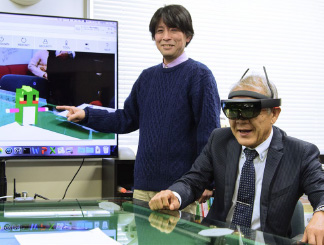
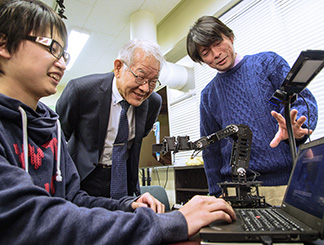
“Yokai (ghost)” has a personality, lives and converses with us in our society, and sometimes plays a trick.Chofu, where UEC is located, is associated with Shigeru Mizuki who is famous with comics and animations of Yokai “GeGeGe no Kitaro”. An objective of research on “YokAI” is an attempt to realize Yokai as a good friend using the AI technology.
The human brain is nothing more than an assembly of cells, but high intelligence emerges from a network of cells.Emergence of high intelligence from interacting autonomous agents as a whole is called “swarm intelligence”.The laboratory develops the swarm-intelligence-type AI that supports our lives and works by learning human behaviors and predicting our actions. Professor Kurihara thinks that the integration of such swarm intelligence with 3D goggles to which AR technology is implemented will enable the “YokAI” to live in the AR to predict our actions communicating with us, to teach us how to act.
AIs like the “YokAI” that acquires the capability of understanding our intention without verbal communication will play an important role for keeping houses, serving customers and taking care of the elderly in aged societies.
Interaction among agents produces a highly intelligent AI, and the AI gives wealth to human lives and societies through communication with humans. There remain ethical issues and we need to make a guideline to avoid an improper use. At any rate, we can find a philosophy of Comprehensive Communication Sciences in this research that tries to improve our lives utilizing various types of communications and interactions.
President Fukuda:
I understood well that Professor Kurihara is investigating the swarm-intelligence-type AI that gives us wealth and happiness, looking ahead its potential influence on societies. A scope of what will communication between AIs and humans yield is important for carrying out research on AI considering possible risks.
Cluster II, which is responsible for research on robotics, control engineering and security science, is a new academic field that integrates information and engineering. I visit Yokoi Laboratory investigating the fusion between humans and machines, particularly the medical engineering application.
President Fukuda:
Professor Hiroshi Yokoi is investigating human-machine fusion systems through the development of myoelectric upper limb prosthesis. What does the system in which humans and machines mutually enhance their capabilities look like?
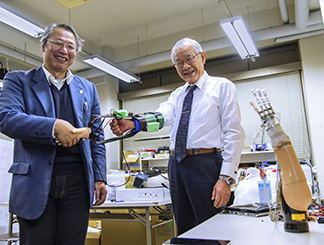
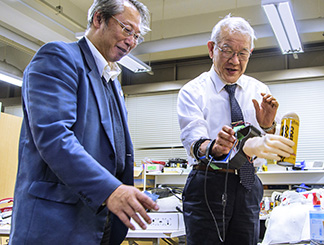
There is an expression “to fit one’s hands better”. The human-machine fusion system is to quantify the feeling of “fitting” and to attempt to increase the adaptability of manufactured artifacts using information processing and control technology.Briefly speaking, we try to fabricate tools that fit one’s hands better, making the best use of system engineering.
Myoelectric upper limb prosthesis that we developed consists mainly of two aspects: the extraction of biological signals reflecting how a user intends to move from weak muscular activities; and the control of an external device based on the biological signals.
It is important to take into account not only changes in the machines but also some changes in a user of the prosthetic hand.
Our objective is to construct a system theory that describes how machines and humans enhance their own capabilities by adapting to each other, utilizing both the adaptation technology of machines to humans and the human potentiality of adaptation to machines.
The idea of trying to overcome the barrier between humans and artifacts in communication and control agrees with the philosophy of Comprehensive Communication Sciences.We investigate how machines and humans learn, evolve and adapt to each other. In parallel to engineering research on machines, we carry out research on human brain activity and physical ability.It is difficult for a researcher to have a thorough knowledge of these scientific and engineering fields. So the collaborations with companies and oversea researchers are indispensable. Furthermore, we try to have opportunities to learn directly from researchers carrying out cutting-edge research.
President Fukuda:
I was surprised that I could make the prosthetic hand to grasp an object only after a few sessions of training to manipulate the hand. It can be said that an attempt to realize an abstract concept of “to fit one’s hands better” gives rise to a new paradigm in material science and medical science as well as robotics. From now on, such a paradigm shift will spread over the research fields of rehabilitation equipment and surgical robots.
In Cluster III, which is responsible for research on material/device science, photonics and biotechnology, students can learn basic science and engineering to support manufacturing by which the environment and humans become harmonious with each other. I visit Iwasawa Laboratory that investigates fuel cells that will play a central role in the energy supply system of the next generation.
President Fukuda:
To realize a sustainable society, the energy problem is an inevitable issue. What is a frontier of fuel cell research that Professor Yasuhiro Iwasawa is carrying out?
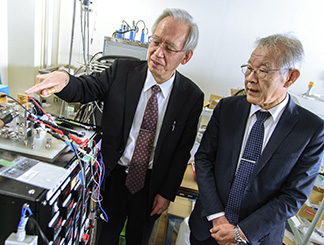
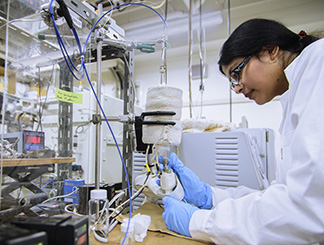
To realize a sustainable society in which we can live with wellbeing and happiness, environmentally friendly energy is indispensable.The fuel cell that generates electricity from hydrogen and air without emission of global warming gases is a next generation technology to realize hydrogen societies making the best use of water abundant in the natural environment.A key factor to promote research on fuel cells is “catalysts” that facilitates chemical reactions.Platinum, metal that exists rarely in nature and hence expensive, is used in a fuel cell as a catalyst. In order to make fuel cells popular, it is therefore necessary to reduce the amount of platinum for decreasing the production cost and to increase the durability of the fuel cell.It has been difficult to reveal how platinum behaves in the fuel cell, although we need to know it for those purposes.
We successfully developed a cutting-edge technology called “XAFS (X-ray Absorption Fine Structure)”, which enables us to observe local structures around platinum atoms in the fuel cell.
Using this X-ray technology, it became possible to observe spatiotemporal changes in the internal structure of the fuel cell that is generating electricity.
We obtain various kinds of valuable information to promote the development of fuel cells based on the in situ observation of chemical reactions.Needless to say, fuel cells are investigated on the basis of electrochemistry and surface science. However, the development of fuel cells further requires the fusion of many different fields of research: spectroscopy and synchrotron radiation science for X-ray measurements and analyses; and catalytic chemistry and material science for the improvement of fuel cells based on the analyzed data.An approach to the creation of innovations from the fusion of different disciplines is just the philosophy of Comprehensive Communication Sciences, in which we regard the combination and integration of various disciplines as very important.
President Fukuda:
In times of natural disasters, fuel cells supply emergency power; the fuel cell technology supports energy security in Japan. The integration of various kinds of specialized fields yields research aiming at our future wellbeing in this way. It becomes more important to facilitate the integration of different disciplines overcoming sectionalism also in UEC.